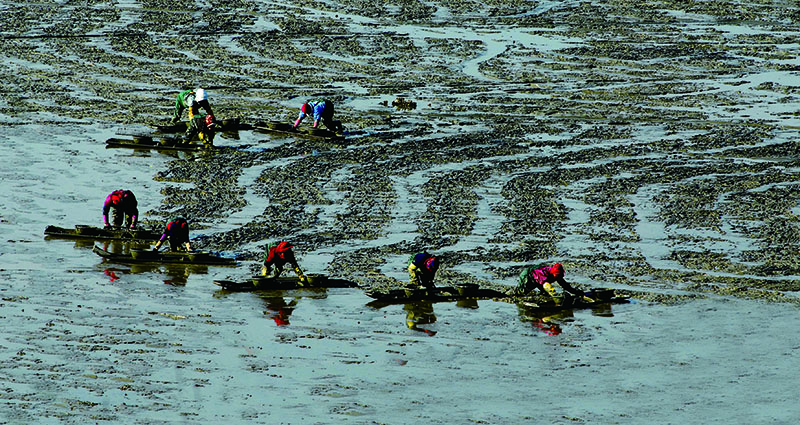한국의 갯벌Introduction

- Wide salt marsh and diverse halophytes
-
Boseong-Suncheon Getbol is formed within Yeojaman Bay. As the tidal current in Yeojaman Bay flows counterclockwise, the fine sediments supplied from the open sea form the mud flat. Additionally, the inflow of fresh water from nearby rivers has a significant impact on the development of halophytes in salt marshes.
In Boseong-Suncheon Getbol, mud flats are dominant as they have been formed furthest from the Geumgang River system, the origin of suspended sediments. The characteristic of the tidal flat’s particles is that they are finer than the other components of the serial properties. Developed salt marshes and halophyte colonies are observed at the estuary where fresh water from the river flows into the sea. This is because wide salt marshes and halophyte colonies are observed in Boseong-Suncheon Getbol.
Boseong-Suncheon Getbol supports 188 species of benthic diatoms, around 23 species of marine algae, around 445 species of macrobenthos, 120 species of waterbirds with estimated population of 270,000 individuals. The characteristic of the tidal flats is that the habitat diversity is less than that of other components. Most of the tidal flats are made up of mud flats, except for Jangdo Island area. However, the development of salt marshes composed of halophytes and reeds provide natural home through the production of organic matters and a hiding place for organisms in the tidal flats, protecting them from predators and the sunlight, thereby increasing the diversity of species.

The representative waterbird in Boseong-Suncheon Getbol is the Hooded Cranes, with the highest number in the RO Korea. It has been expected to observe 900 individuals in a year. In addition, the region has recorded 27 waterbirds species listed on the IUCN Red List including Common Pochard. It has also been confirmed to habitat endangered benthic invertebrates such as Covex Crabs (Chasmagnathus convexus), Neritid Freshwater Snails (Clithon retropictus), Red-foot Crab, Chinese Midas-ear Snails (Ellobium chinense), MilkyFiddler Crabs (Uca lactea) and etc.

In the Boseong-Suncheon Getbol, fishing activities using a traditional flat-bottomed boat called “Bbeolbae”, have developed. This development has occurred due to the unique feature of the finest mud among the serial components, making it very easy for people to sink deeply when they enter into the fine mud flats. It is known to have been used as a means of transportation for around 120 years, and it is likely that it had been used even earlier, as clams were recorded in the book of ‘Dongguk Yeoji Sunglam (published in 1481)’ as Boseong’s specialty product.
